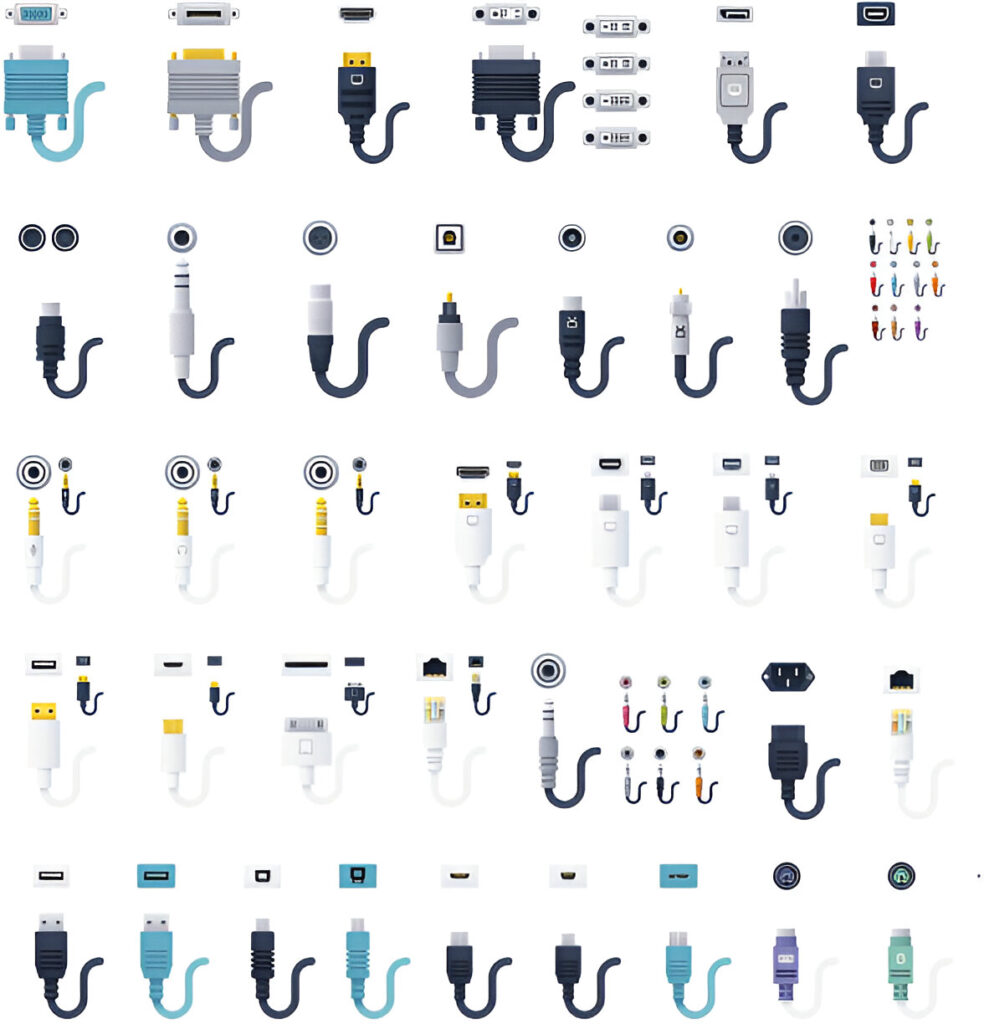Understanding Audio Connectors and Cables
Audio connectors and cables are key parts of any sound system. They carry signals between devices and affect sound quality. Knowing the basics helps you pick the right ones for your needs.
Anatomy of Audio Cables and Connectors
Audio cables have a few main parts. The outer jacket protects the inner wires. Inside, you’ll find conductors that carry the sound signal. Some cables have shielding to block noise.
Connectors are the plugs at the ends of cables. Common types include:
- 3.5mm (mini-jack): Found on phones and laptops
- 1/4 inch (6.35mm): Used for guitars and pro audio gear
- XLR: Popular in recording studios
- RCA: Often seen on home stereos
Each connector has a specific shape and number of contact points. This determines what kind of signal it can carry.
Balanced vs. Unbalanced Audio
Audio cables come in two main types: balanced and unbalanced.
Unbalanced cables:
- Use two wires (signal and ground)
- Are simpler and cheaper
- Work well for short distances
- Can pick up noise over long runs
Balanced cables:
- Use three wires (positive, negative, and ground)
- Cancel out noise
- Are better for long cable runs
- Cost more but give cleaner sound
For home use, unbalanced cables often work fine. But if you’re running cables over 20 feet, balanced is better.
Analog vs. Digital Audio Fundamentals
Audio signals can be analog or digital. This affects how they’re sent through cables.
Analog audio:
- Is a continuous electrical signal
- Sounds more natural to some ears
- Can lose quality over distance
- Uses connectors like RCA and 1/4 inch
Digital audio:
- Is made up of ones and zeros
- Doesn’t degrade over distance
- Can carry more channels of audio
- Uses connectors like HDMI and optical
For high-quality sound over long distances, digital is often best. But many musicians prefer analog for its warmth and character.
Common Connector Types and Their Uses
Audio connectors come in many shapes and sizes. Each type serves a specific purpose in different audio setups. Let’s look at the most common connectors you’ll find in professional and home audio systems.
XLR Connectors for Professional Audio
XLR connectors are the go-to choice for pro audio gear. You’ll see them on microphones, mixing boards, and high-end speakers. They have three pins and a locking mechanism that keeps them secure.
XLR cables are great for long runs because they reject noise. This means your audio stays clean, even over long distances. Many pro microphones use XLR because it can supply phantom power.
In recording studios, you’ll find XLR connectors everywhere. They’re also common in live sound setups for concerts and events.
RCA Connectors in Home Entertainment
RCA connectors are those colorful plugs you often see on the back of TVs and stereos. They usually come in pairs – red for right audio and white for left.
You’ll use RCA cables to connect things like:
- CD players to amplifiers
- TVs to soundbars
- Turntables to stereo systems
RCA connectors are simple to use. Just match the colors and plug them in. They’re not as sturdy as XLR, but they work well for home setups where cables don’t get moved around much.
Phone Connectors: TS, TRS, and Minijack
Phone connectors come in a few sizes. The big ones (1/4 inch) are common on guitars and keyboards. The small ones (3.5mm) are what you use for headphones.
TS connectors have one ring and carry mono audio. They’re great for electric guitars.
TRS connectors have two rings. They can carry stereo audio or a mono signal plus control data. You’ll find them on headphones and some microphones.
The 3.5mm minijack is super common. It’s on smartphones, laptops, and portable speakers. Most consumer headphones use this size.
Digital Connectors: HDMI, Toslink, and Coaxial
Digital connectors carry audio in the form of data. This can give you better sound quality than analog connectors.
HDMI is the standard for connecting TVs to cable boxes, game consoles, and Blu-ray players. It carries both high-quality audio and video in one cable.
Toslink uses optical cables to send digital audio. You might use it to connect a TV to a soundbar or receiver.
Coaxial digital uses a single RCA-style connector. It’s an older standard but still found on some audio gear. It can carry high-quality digital audio between devices.
These digital options are great for home theater setups. They can handle surround sound formats and high-resolution audio.
Connector and Cable Features
Audio connectors and cables play a big role in sound quality. The build and materials used can affect how well your audio gear works. Let’s look at what makes a good connector and cable.
Importance of Connector Build Quality
Good connectors are key for clear sound. Look for connectors made of tough metals like gold or nickel. These last longer and resist corrosion. Locking connectors are great for keeping cables in place. They’re useful for speakers and mics that move a lot.
Male connectors (the part that sticks out) should fit snugly into female connectors (the part with a hole). A loose fit can cause static or signal loss. For pro audio gear, check out XLR connectors. They’re strong and have a satisfying “click” when plugged in.
Understanding Different Cable Materials and Shielding
The inside of a cable is just as important as the outside. Copper is a popular choice for its good signal transfer. Some high-end cables use silver, which can give even better sound.
Shielding keeps out unwanted noise. Look for cables with braided shields for the best protection. This is extra important for long cable runs or areas with lots of electronics.
For home audio systems, oxygen-free copper (OFC) cables can improve sound quality. If you’re setting up a recording space, balanced cables help cut down on noise over long distances.
Remember, thicker cables aren’t always better. Choose based on your needs. Mic cables need different specs than speaker wires. When in doubt, check your audio interface manual for the best cable types to use.
Specialized Connectors for Specific Functions
Some audio setups need special connectors. These help with things like live shows, speakers, and small devices. Let’s look at a few important ones.
Speakon Connectors for Live Sound
Speakon connectors are great for live music. They lock in place, so they won’t come loose during a show. This keeps the sound going strong.
You’ll often see Speakon connectors on big speakers and amps. They can handle lots of power without getting hot. This makes them safe for long concerts.
Speakon connectors also keep the signal clean. They have separate pins for positive and negative. This means less noise in your sound.
Banana and Speaker Pins for Speaker Cables
Banana plugs make hooking up speakers easy. You just push them into the holes on your amp or speaker.
These plugs come in pairs – red and black. This helps you keep the positive and negative wires straight.
Speaker pins are like skinny banana plugs. They work well when space is tight. You might use them for small speakers or car audio.
Both types grip firmly. This means a good connection and clear sound. They’re also easy to swap if you change your setup often.
MCX and MMCX Connectors for Personal Audio
MCX and MMCX connectors are tiny but tough. You’ll find them on some fancy earbuds and small antennas.
MMCX is a bit smaller than MCX. It can spin around without breaking. This is handy for in-ear monitors that get a lot of use.
These connectors snap together with a click. They stay put but you can still take them apart when needed.
The small size lets makers put them in slim devices. You get great sound without bulky plugs. But be gentle – they can be fragile if you’re too rough.
Connecting Different Audio Systems
Connecting various audio devices can be tricky. You might need to use adapters or set up complex multi-channel systems. Let’s look at some ways to link different audio equipment.
Adapting and Extending Connections with Adapters
Adapters are your best friends when connecting mismatched audio gear. If you have a 3.5mm plug but need a 1/4-inch jack, there’s an adapter for that. RCA to XLR adapters let you hook up pro gear to home systems. Some adapters even change digital signals to analog.
For Dolby Atmos setups, you might need HDMI adapters to connect extra speakers. When linking musical instruments, a 1/4-inch to XLR adapter can help. Always check your gear’s inputs and outputs before buying adapters.
Bi-Wiring and Multi-Channel Audio Setups
Bi-wiring can boost your sound quality. It uses two sets of wires from your amp to each speaker. This splits high and low frequencies for clearer audio.
For surround sound, you’ll need to connect multiple speakers. A 5.1 system has five speakers plus a subwoofer. 7.1 adds two more speakers. Make sure your receiver has enough outputs for all your speakers.
Dolby Atmos systems add height channels. You might need to run wires to ceiling speakers or use special up-firing speakers. Check your receiver’s manual for the right way to connect everything.

